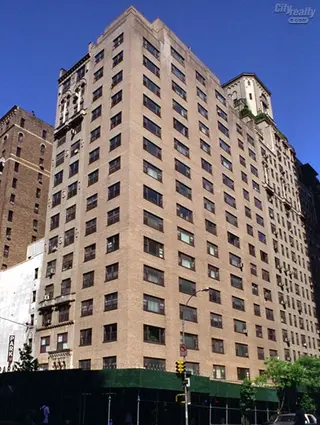 Carter Horsley
Carter HorsleyDec 23, 2011
Carter's Review
New York City is well known for its real estate "holdouts" and part of this apartment house, the corner, occupies one of the most famous.
"Holdouts" are owners who decline to sell their property to developers owning adjacent or surrounding properties in the hope, usually, of getting more money. Sometimes they are successful, but often they are frustrated as the developers give up negotiations and build around them.
Here, the developer, Vivian Green, commissioned architect Robert T. Lyons to design a very handsome apartment building with Italian Renaissance detailing at the very prominent corner only to have to alter his plans and build around the holdout. The result was a midblock building, completed in 1931, on Park Avenue connected only at the street level with a midblock building on 34th Street.
In the middle, at the corner, was the rather large townhouse of Mrs. Robert W. Bacon. Her house originally was a three-story house with a large stoop, gables and an iron fence that dated to the mid-19th Century and was eventually enlarged in 1882 and again in 1899 when the architectural firm of Howard Cauldwell & Morgan combined several properties on the site in a fairly homogeneous manner with the original design.
In their excellent book, "Holdouts" (McGraw Hill Book Company, 1984), Andrew Alpern and Seymour Durst, recount that when Fourth Avenue was renamed Park Avenue the Bacon property became known as One Park Avenue only to officially lose that address in 1924 when developer Henry Mandel convinced the city to extend the name of Park Avenue south two blocks to where he wanted to erect an 18-story office building on the site of horse-car stables.
Martha Bacon, whose husband was a former Secretary of State and Ambassador to France, however, was not amused, the authors continued, and she legally challenged the city's action, losing only in the state's highest court. Her husband died five years before the final court action. Mrs. Bacon was able to retain her exclusive "One Park Avenue" address on in the phone book, according to Alpern and Durst.
The surrounding, two-part apartment building had 10 apartments per floor in the 34th Street section and two apartments per floor in the Park Avenue section and each of the sections had their own set of fire-stairs and elevators. Mrs. Bacon's death in 1940, however, did not lead to a quick resolution of the corner situation because of delays over her estate and a disputed mortgage lien and the house was boarded up for years.
Finally, in 1953, the Bacon house was demolished and replaced with an expansion to the apartment building that added four apartments per floor. No attempt was made in the design of the expansion by architect David Moed, however, to maintain the architectural style of the earlier design and the new expanded section is rather minimalist, as was the "modern" vogue at the time.
All "three" buildings that now comprise 7 Park Avenue are joined by a large and long multi-leveled lobby that has patterned terrazzo floors, a fireplace, chandeliers and a vaulted ceiling. The apartments in the original two buildings of the project have 9-ft.-high, beamed ceilings, picture moldings and arched doorways. One resident of the building has noted that the building's "obviously pre-war lobby led a broker showing...an apartment in the new section to try to convince...[him] that the generic apartment he was showing was, in fact, a prewar." "The net result of all of this is that depending on what section of 7 Park one lives in, the experience is completely different from living in one of the other sections."

- Co-op built in 1930
- 1 apartment currently for sale ($1.3M)
- 1 apartment currently for rent ($4.8K)
- Located in Murray Hill
- 226 total apartments 226 total apartments
- 10 recent sales ($329K to $875K)
- Doorman
- Pets Allowed

 6sqft delivers the latest on real estate, architecture, and design, straight from New York City.
6sqft delivers the latest on real estate, architecture, and design, straight from New York City.
